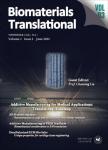Optimising soft tissue in-growth in vivo in additive layer manufactured osseointegrated transcutaneous implants
作者机构:Institute of Orthopaedic&Musculoskeletal ScienceUniversity College LondonRoyal National Orthopaedic HospitalStanmoreUK Barts and the London School of Medicine and DentistryQueen Mary University LondonLondonUK School of Pharmacy and Biomedical SciencesUniversity of PortsmouthPortsmouthUK Writtle University CollegeWrittleUK
出 版 物:《Biomaterials Translational》 (生物材料转化电子杂志(英文))
年 卷 期:2022年第3卷第4期
页 面:243-249页
学科分类:1002[医学-临床医学] 100214[医学-肿瘤学] 10[医学]
基 金:This study was financially supported by a UCL Impact Studentship in collaboration with Fitzpatrick Referrals Ltd.(award No.174064) European Commission via H2020 MSCA RISE BAMOS programme(project No.734156) Versus Arthritis(project No.21160) the Rosetree Trust(project No.A1184) and the Innovate UK via Newton Fund(No.102872)
主 题:in-vivo model ITAP orthopaedic implants osseointegrated transcutaneous implants
摘 要:Osseointegrated transcutaneous implants could provide an alternative and improved means of attaching artificial limbs for amputees,however epithelial down growth,inflammation,and infections are common failure modalities associated with their *** overcome these problems,a tight seal associated with the epidermal and dermal adhesion to the implant is *** could be achieved with specific biomaterials(that mimic the surrounding tissue),or a tissue-specific design to enhance the proliferation and attachment of dermal fibroblasts and *** intraosseous transcutaneous amputation prosthesis is a new device with a pylon and a flange,which is specifically designed for optimising soft tissue *** the flange has been fabricated using traditional machining techniques,however,the advent of additive layer manufacturing(ALM)has enabled 3-dimensional porous flanges with specific pore sizes to be used to optimise soft tissue integration and reduce failure of osseointegrated transcutaneous *** study aimed to investigate the effect of ALM-manufactured porous flanges on soft tissue ingrowth and attachment in an in vivo ovine model that replicates an osseointegrated percutaneous *** 12 and 24 weeks,epithelial downgrowth,dermal attachment and revascularisation into ALM-manufactured flanges with three different pore sizes were compared with machined controls where the pores were made using conventional *** pore sizes of the ALM flanges were 700,1000 and 1250μ*** hypothesised that ALM porous flanges would reduce downgrowth,improve soft tissue integration and revascularisation compared with machined *** results supported our hypothesis with significantly greater soft tissue integration and revascularisation in ALM porous flanges compared with machined controls.



